
Beyond Becoming an Outdoors-woman Trapping Camp participants spent time outdoors at Siloam Springs State Park learning to interpret wildlife sign. All photos by Kathy Andrews Wright unless otherwise noted.


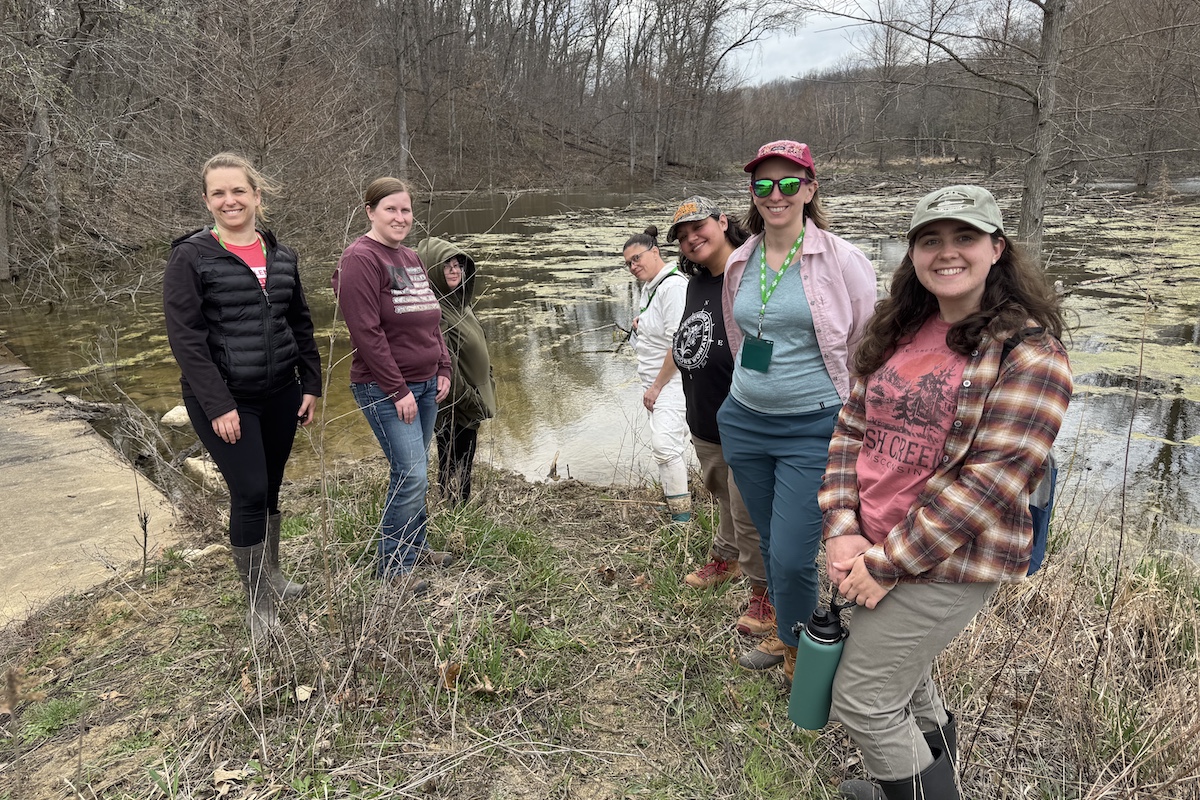
Beyond Becoming an Outdoors-woman Trapping Camp participants spent time outdoors at Siloam Springs State Park learning to interpret wildlife sign. All photos by Kathy Andrews Wright unless otherwise noted.
Savory aromas emanated from the Sunday wrap-up luncheon, greeting the 22 women who had spent two breezy March days outdoors at the Illinois Department of Natural Resources’(IDNR) Beyond Becoming an Outdoors-woman (BOW) Trapping Camp. A warm, hearty meal was certainly welcomed. Perhaps a few approached the table with trepidation, unsure what to think of the main course: beaver chili and venison chili.
Both chilis had been prepared by Dean Corgiat, Site Superintendent at Siloam Springs State Park’s Western Illinois Complex and one of the instructors at the BOW Trapping Camp. Both were made with the exact same recipe so the women could fully appreciate the taste differences of the two game meats. Familiar to many was the rich, earthy and somewhat woodsy flavor of venison. It was the milder, somewhat beefy flavor of beaver that was a new experience for most diners.
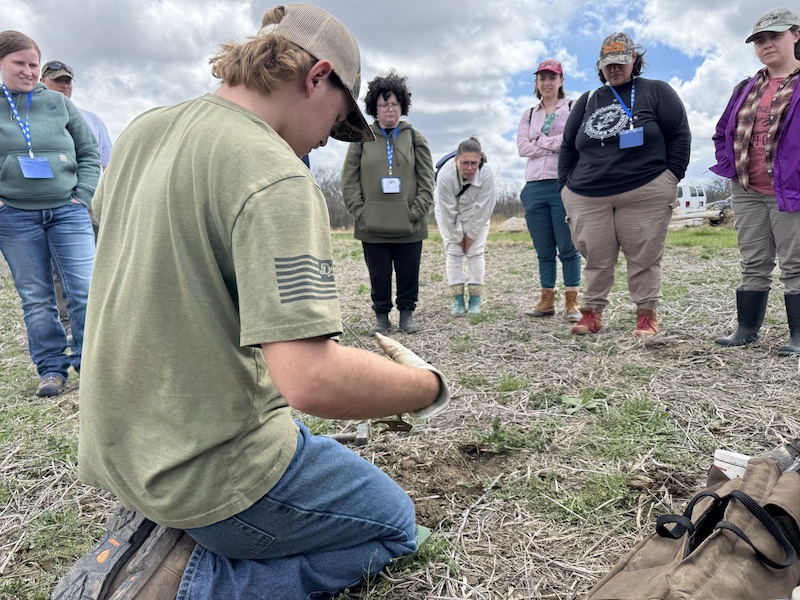
“The beaver chili blew me away,” Cyndi Fecher said. “I’ve had venison several times and after tasting the beaver I’d absolutely enjoy being able to cook it myself.”
Holly Tuten also found the dinner spread exciting, saying “I was surprised by how good the beaver chili was.”
Also served—and found to be delicious by the diners—were beaver and deer jerkies and venison pemmican, a nod to the meat, nut and berry concoction that sustained many Native Americans while on the trail.
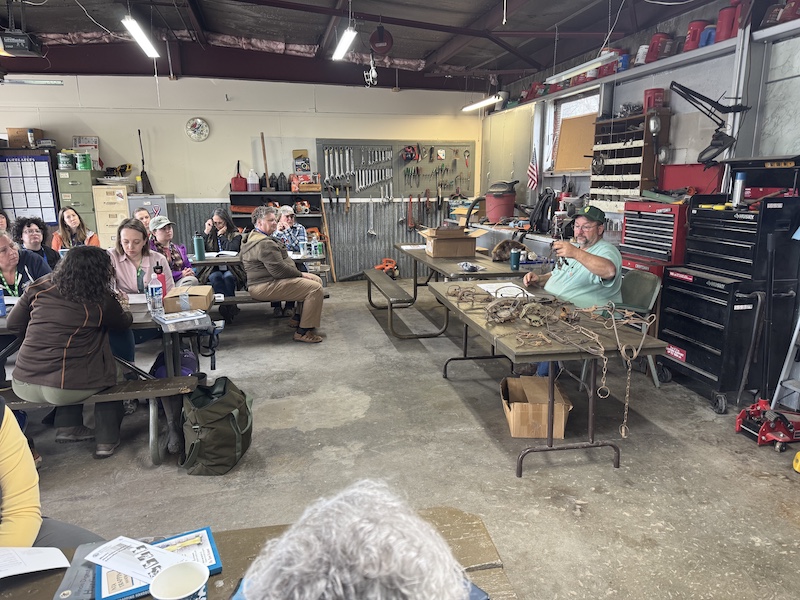
Named IDNR BOW coordinator in 2023, Lisa Demeule designed the Trapping Camp program according to the original spirit and purpose of BOW: to provide hands-on learning opportunities that empower women to develop outdoor skills in a supportive environment.
“The foundational vision of BOW typically divides class offerings into three parts—hunting, trapping and shooting sports, fishing-related skills, and non-harvest activities such as camping, canoeing and other outdoor recreation,” Demeule explained. “In recent seasons, I’ve placed a renewed emphasis on hunting, trapping and fishing workshops and found the responses overwhelmingly positive. Participants are not only interested but are eager for deeper, more immersive experiences that go beyond introductory-level instruction.”
These immersive workshops fall under the title of Beyond Becoming an Outdoors-woman.

According to Dean Corgiat, trapping is a dying, and often misunderstood, wildlife management tool. Trapping is a labor and time intensive pursuit and Corgiat explained that the decline in fur prices over the last few decades has decreased the number of people able to earn an income from trapping. Many have given it up. And today, too few in society recognize the culture, history and values of modern trapping, the role it played in North American history and its continued role in modern wildlife conservation.
“When I started in the mid-seventies, fur prices were booming and it was difficult to even find a place to trap,” Corgiat explained. “I tell youth that now is the time to learn how to trap as there is no competition and veteran trappers are willing to share information. When I started it was difficult to even find someone to help you out.”
Demeule designed the weekend Trapping Camp to provide participants with a broad understanding of the science—and art—of modern, regulated trapping and to recognize the pivotal role it plays in helping maintain balanced ecosystems, managing populations and its contribution to broader environmental goals. The history of unregulated trapping is well known to most people, but modern, regulated trapping does not cause wildlife to become endangered and populations are monitored so that harvest does not jeopardize the populations.

Kicking off the two-day workshop was Mike Vose, an IDNR Trapper Education Instructor and a member of the Illinois Trappers Association who lead the classroom component of the Illinois Trapper Education Course. That afternoon, participants rotated through sessions where they learned about foxes, coyotes and bobcats from Blake Ruebush, James Blakely and Eli Blakely; about beavers and river otters from Madison Daniels and Mike Vose; and about mink, muskrats and raccoons from Kory McAllister and Weston McAllister.
Putting their new-found knowledge to use came next as each woman practiced setting DP (dog-proof) raccoon traps. Thanks to a generous donation by Duke Traps each woman took home a set of traps.
After the scrumptious Saturday BBQ dinner provided by the Mississippi Valley Hunters and Fishermen’s Association, Steve Moore and his daughter Madelyn introduced the group to some basic techniques for sewing furs while making a fur headband with a raccoon pelt.
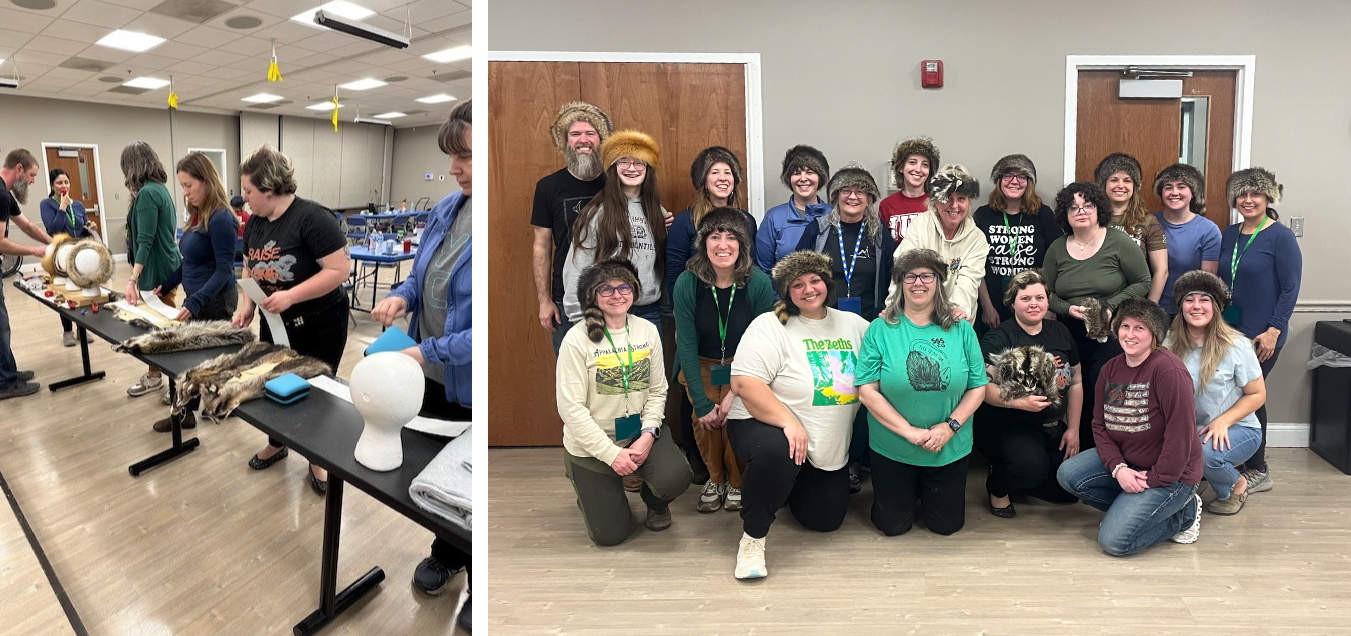
“The ladies seemed to really enjoy exploring the cultural richness of trapping and history of hand-sewn fur garments,” Demeule said. “Some women bought pelts to take home and make other products. One participant got creative and made a purse without using a pattern.”
Sunday morning broke with the risk of severe weather looming, which required indoor demonstrations on how to skin pelts—opossum, raccoon, river otter, beaver and muskrat—and prepare furs for market.
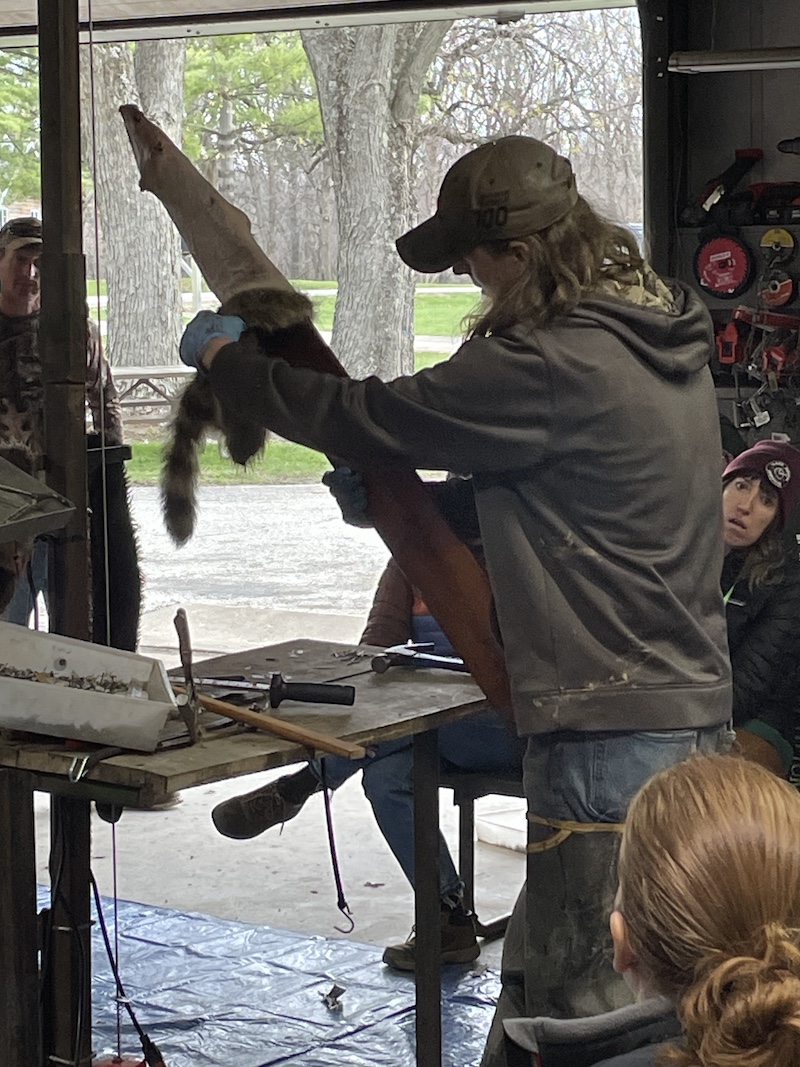
Growing up, Holly Tuten read each Foxfire book from cover to cover. Her passion to learn about nature and historical lifestyles continued into adulthood. A desire grew to introduce her family to outdoor living skills and led her to a web search in early 2025 that, coincidentally, occurred the day the IDNR Beyond BOW workshop was announced. She immediately signed up.
“I was impressed that this workshop had such a concentration of experts and how comfortable they were imparting their real-world knowledge and experiences with us,” Tuten remarked. “This workshop provided practical and hands-on experiences that I found incredibly helpful.”
While Tuten has a background in biological sciences with an expertise in medical entomology, reading wildlife sign is a new activity.
“I’m taking the time now to develop my skills at reading wildlife sign and am including my children in this learning experience,” she explained, recognizing that in her case the learning process will take multiple years as she learns and involves her children. “Our family time outdoors now includes what we call ‘Be a Nature Detective’ time where we look for trails, fur or scat and then explore those in detail.”
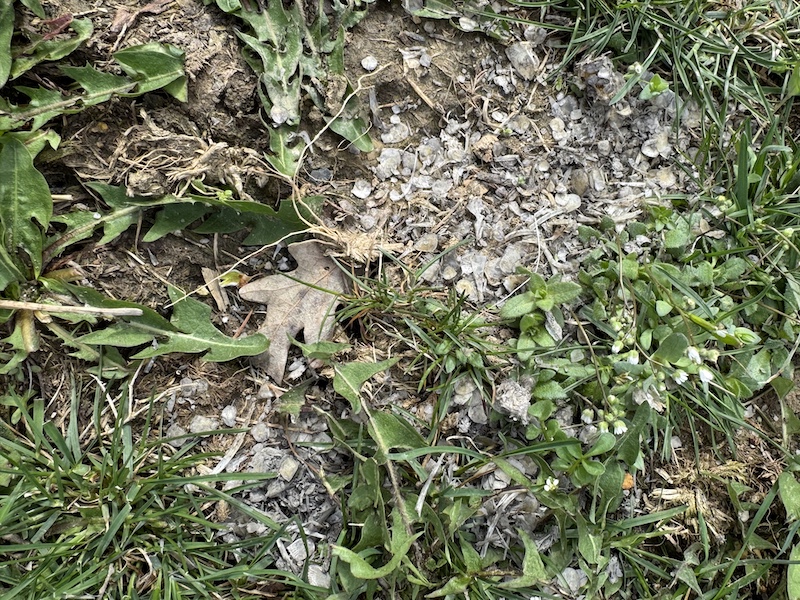
Based on her experience, Tuten advises other women to not let the words on the page describing these ‘woodsman’ workshops psyche you out.
“Take a breath and then decide to give these workshops a chance,” she continued. “The way these courses are designed accommodates your lack of confidence in your current skills and knowledge. Get excited and jump in! You can do it.”
Cyndi Fecher Layman grew up in the Appalachian mountains of Virginia, moving to northeast Illinois in middle school, and she has always enjoyed being outdoors, whether it is camping, hiking, backpacking or gardening.
“I’m eager to find ways to get closer to the land and be outdoors,” she explained. “When a friend mentioned wanting to attend the Trapping Camp it was just the push I needed to try a new outdoor experience.”
While she doesn’t live in an area where she can practice her new-found skills she’s planning to tag along with local trappers to continue pushing herself to learn and explore nature.
“It was so wonderful having the opportunity to get out of my comfort zone and learn something with a group of like-minded women,” she noted. “All involved with organizing this workshop were welcoming, knowledgeable and generous with their time and attention.”

Dean Corgiat has taught numerous outdoor related classes to all walks of life—men, women, youth, colleges, high schools, master gardeners, biologists, game wardens, site superintendents and more.
“I have taught BOW classes on squirrel hunting, turkey hunting, trailer backing and trapping and no other class can compare to BOW classes,” he said. “The sheer enthusiasm of the ladies is incredible. They listen, ask great questions, support each other, are appreciative and have fun.”
Corgiat was struck by the fact that an overwhelming majority of the Trapping Camp participants plan on actively participating in trapping this fall.
“My hope for this class was to have the ladies leave with an understanding of trapping,” he continued. “I thought maybe just a small handful would be interested enough to try it out. This was one of the few times in my life that I’ve been happy to be wrong!”
Trapping Camp was a rich opportunity for instructors to share the story of trapping in North America and their experiences as stewards of wildlife and wild lands. The participants appreciated that the immersive experience allowed them to gain a broader understanding of the culture, history and values of modern trapping.
Kathy Andrews Wright retired from the Illinois Department of Natural Resources where she was editor of OutdoorIllinois magazine. She is currently the editor of OutdoorIllinois Journal.
Submit a question for the author